Nike has been a pioneer in the sportswear industry for over five decades, evolving from a performance-focused brand to a fashion icon. The company was founded on January 25, 1964, as Blue Ribbon Sports by Bill Bowerman and Phil Knight. It officially became Nike, Inc. on May 30, 1971, taking its name from Nike, the Greek goddess of victory. This transformation marked the beginning of Nike’s journey to becoming one of the most recognized and influential brands in the world.
Nike’s ascent to fashion prominence began in the mid-80s with its partnership with Michael Jordan, launching the Air Jordan line. This collaboration was a game-changer, not only boosting Nike’s credibility in the athletic market but also establishing its presence in the fashion industry. The success of the Air Jordan line demonstrated that sportswear could be fashionable, leading to a broader cultural shift where athletic apparel became everyday wear.
Despite being primarily recognized as a fashion label post-80s, Nike’s early designs still hold a special place in fashion history. The quality and design of vintage Nike clothing from the 70s and 80s are highly regarded, with a surge in popularity for these items in recent years. Vintage Nike is distinguished by its unique logos, tags, designs, and materials, each telling a part of the brand’s rich history.
Nike’s logo evolution is a key indicator of its vintage status. From 1964 to 1971, when the company was known as Blue Ribbon Sports, the logo featured bold, geometric initials “BRS” with “Blue Ribbon Sports” in a clean sans-serif font below. The iconic “Swoosh” logo was introduced between 1971 and 1976, initially combined with the word “nike” in a cursive, handwritten style, reflecting athleticism and movement. By 1976, the Swoosh stood alone, symbolizing simplicity and global recognition. A version with a bold, capitalized “NIKE” text alongside the Swoosh has also been used extensively since its introduction.
Tag design, colors, and materials are also critical aspects of identifying vintage Nike. In the 1980s, tags often featured the classic Nike logo with the Swoosh in a bold serif font and included “Made in U.S.A.” or “Made in the U.K.” In the 1990s, tags became more vibrant and intricate, introducing the “Nike Air” and Jordan brand tags. The 70s and 80s favored primary colors and simple, toned-down graphics with discreet logos, while the late 80s and early 90s saw bolder designs with bigger logos and slogans. Most vintage Nike clothing used a 50-50 cotton-polyester blend, with Nike’s Dri-FIT material debuting in the late 2000s. In the rest of this blog, we’ll explore these elements in more detail to help you identify and appreciate vintage Nike pieces.
Nike’s First Ever TV Commercial
How to tell if Nike is vintage from the logo
Nike’s logo evolution is a fascinating journey that reflects the brand’s growth and innovation over the decades. Starting from its humble beginnings as Blue Ribbon Sports, Nike has continuously refined its visual identity to become one of the most recognized brands in the world. Here is a breakdown of the different Nike logos through the years, helping you identify if your Nike product is vintage.
1964 to 1971 Nike logo
- The first logo used by Nike when the company was known as Blue Ribbon Sports (BRS).
- The logo features the initials “BRS” in a bold, geometric design.
- Below the initials, the text “Blue Ribbon Sports” is written in a clean, sans-serif font.
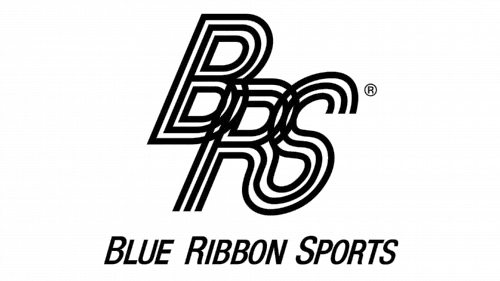
1964 to 1971 Nike logo
1971 to 1976 Nike logo
- This logo marks the introduction of the iconic Nike “Swoosh” and the transition from Blue Ribbon Sports to Nike.
- The Swoosh is combined with the word “nike” in a cursive, handwritten style.
- The design is fluid and dynamic, reflecting the brand’s emphasis on athleticism and movement.

1971 to 1976 Nike logo
1976 to now Nike logo
- The Swoosh logo becomes standalone, removing the text to emphasize the symbol’s simplicity and recognizability.
- This version has been used consistently since its introduction, becoming a global symbol for the brand.
- The design is sleek and minimalistic, aligning with Nike’s modern and innovative image.

1971 to now Nike logo
1976 to now Nike logo
- Introduced a bold and capitalized “NIKE” text alongside the Swoosh.
- The text is strong and prominent, reinforcing the brand’s identity.
- This logo version emphasizes both the brand name and its iconic symbol, used extensively in marketing and product design.
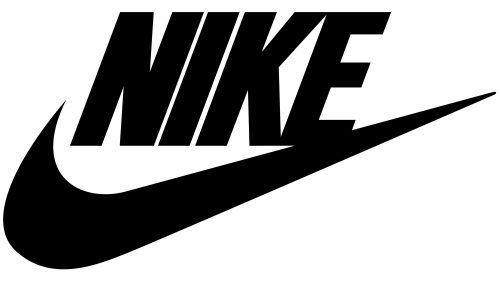
1976 to now Nike logo
How to tell if Nike is vintage from the tags
The best place to start when it comes to identifying vintage Nike is the tags. Essentially every piece of Nike clothing will have a tag at the time of its manufacturing, and because Nike regularly update the design of these tags, we can assess the design to work out which era a vintage Nike piece was made in. It should be noted that due to the nature of global manufacturing, all the timelines of when tags were used are estimates. Even Nike themselves would have a difficult time pinning down an exact date of production based purely on tags.
Having difficulty identifying vintage tags or labels? Upload a picture on our vintage tag identification page, and we’ll assist you!
1980s vintage Nike tags
- Often featured the classic Nike logo with the swoosh in a bold serif font.
- Tags usually had a simple, clean design with “Made in U.S.A.” or “Made in the U.K.”
- Tags were generally rectangular and made of soft fabric or woven material.
- Commonly displayed size indicators alongside the logo.
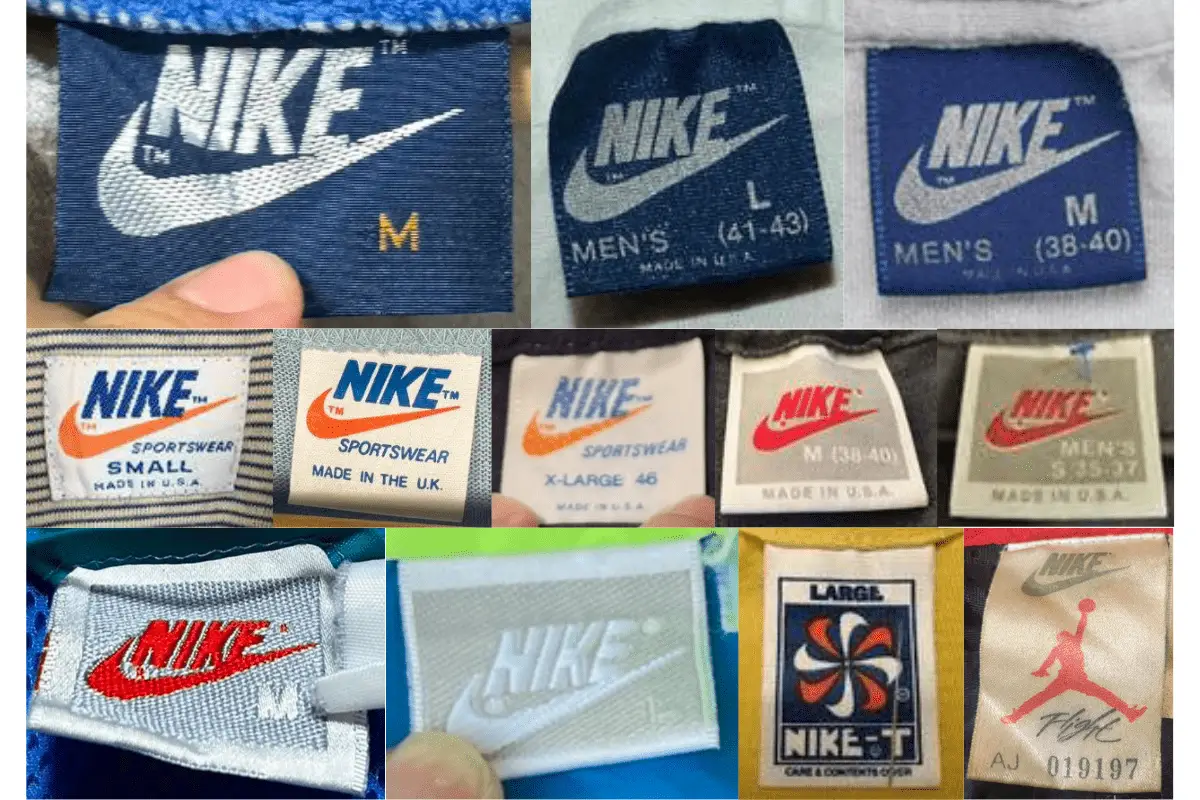
1990s vintage Nike tags
- Introduction of the “Nike Air” and Jordan brand tags.
- Tags featured more vibrant colors and intricate designs.
- Incorporated size information in different formats, often below the logo.
- Materials varied from woven to satin-like finishes, enhancing durability and brand presentation.

2000s vintage Nike tags
- Tags became more modern, incorporating high-tech fabric labels such as Dri-FIT.
- More detailed information about manufacturing location (e.g., made in Pakistan, Cambodia).
- Use of loop tags became more common for better durability and readability.
- Emphasis on Nike’s proprietary technologies and collaboration brands (e.g., Nike SB).

2010s vintage Nike tags
- Further diversification in tag materials and designs, including more eco-friendly options.
- Tags included QR codes and detailed care instructions for global market compliance.
- Increased use of minimalist designs while maintaining the iconic Nike swoosh.
- Reflective and high-visibility elements introduced for athletic wear and performance lines.
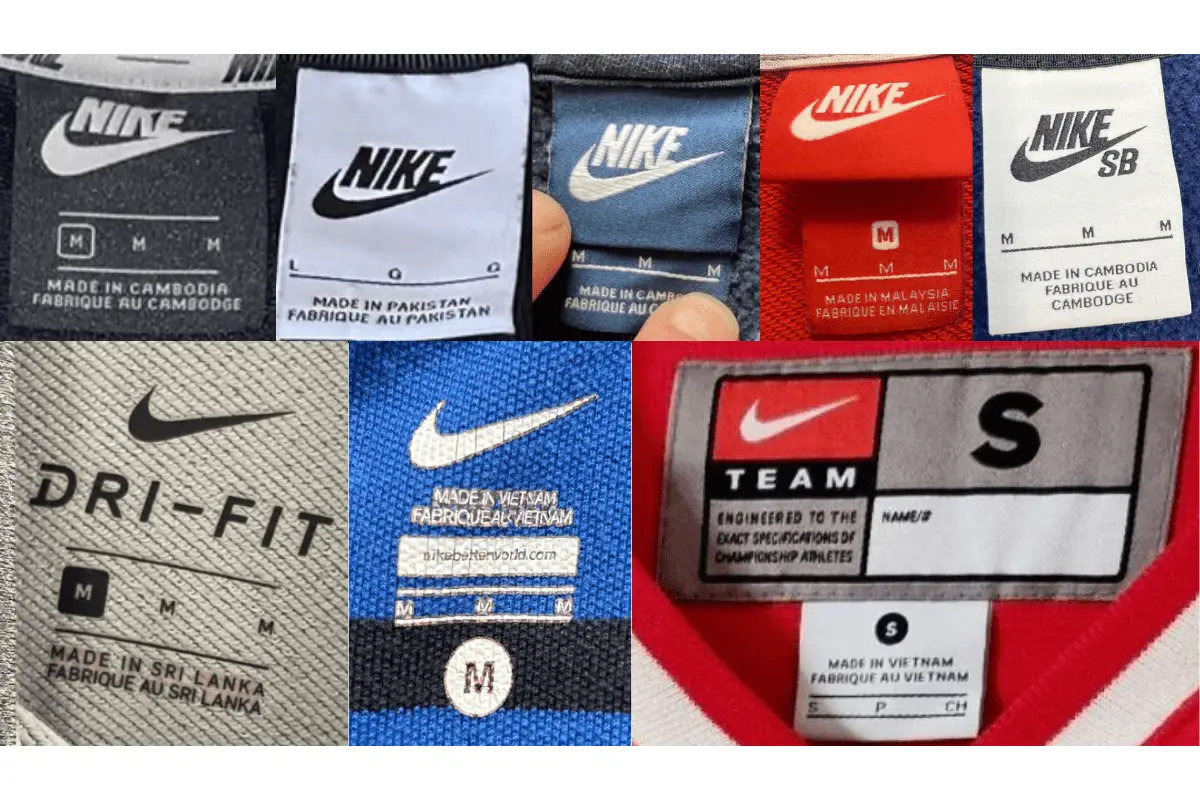
How to tell if Nike is vintage from the design and colours
To identify vintage Nike apparel from the design and colors, it’s essential to understand the brand’s evolution over the decades. During the 70s and 80s, Nike favored primary colors and simple, toned-down graphics for its apparel. The iconic Nike logo, typically discreetly placed on the chest or sleeve, was a hallmark of this era. One distinctive feature of this period was the use of the pinwheel logo, which consisted of a concentric circle of Nike swooshes in alternating colors. This understated yet stylish approach helped establish Nike as a recognizable and respected brand in its early years.
Moving into the late 80s, Nike’s design philosophy began to shift. With a surge in popularity, the brand embraced bolder and more eye-catching designs. Apparel from this period often featured larger logos and more vibrant color schemes, reflecting the growing trend of consumers wanting to prominently display their affiliation with the brand. The shift in design not only catered to the public’s desire to showcase their Nike gear but also aligned with the brand’s evolving image and market presence.
By the early 90s, this trend of boldness in design continued to gain momentum. Nike’s logos became more prominent, and slogans that encapsulated the brand’s ethos were frequently featured on clothing. The use of larger graphics and more assertive branding elements was a strategic move to strengthen Nike’s identity in the competitive sportswear market. Recognizing these changes in design and color schemes is crucial for determining the vintage status of Nike apparel, offering a window into the brand’s dynamic history and its adaptation to consumer preferences over the decades.
How to tell if Nike is vintage from the materials used
One indicator of the age of a Nike item is the materials used to create them. In the 70s, 80s, and 90s, most Nike vintage clothing, such as t-shirts and sweatshirts, typically featured a 50-50 cotton-polyester blend. This blend was favored for its durability and comfort, making it a staple in Nike’s apparel line during these decades. The use of this specific material mix is a reliable clue when trying to determine if a Nike item is genuinely vintage.
In contrast, Nike did not debut its Dri-FIT material until the late 00s. This advanced fabric technology, designed for enhanced moisture-wicking and breathability, became a hallmark of Nike’s modern performance apparel. As a result, if you come across a Nike item made from Dri-FIT or similar high-tech materials, it’s unlikely to be vintage. Understanding the introduction timeline of these materials is crucial for accurately dating Nike clothing.
Furthermore, the absence of contemporary fabrics like Dri-FIT in older Nike items underscores the significant evolution in textile technology over the years. Vintage Nike pieces are often characterized by their simpler, more traditional fabric compositions, which reflect the manufacturing capabilities and consumer preferences of their time. Recognizing these material differences not only helps in authenticating vintage Nike apparel but also offers insight into the brand’s progression in garment innovation.
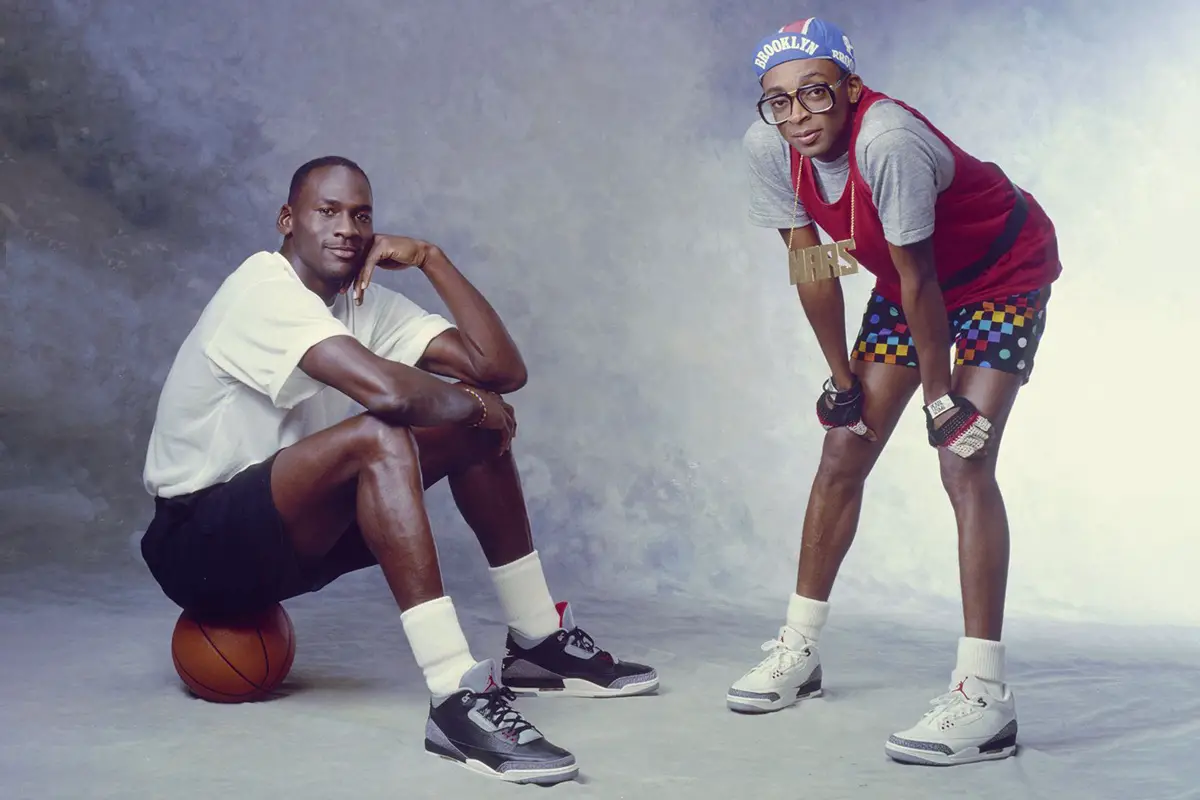




I am really impressed along with your writing talents as neatly as with the layout on your blog.
Is that this a paid subject or did you modjfy it youur self?
Either way stay up the nice quality writing, it’s uncommon to peer a
great weblog like this one these days.. http://Boyarka-Inform.com/
This website, you can find a great variety of online slots from top providers.
Players can try out traditional machines as well as modern video slots with stunning graphics and interactive gameplay.
Whether you’re a beginner or a casino enthusiast, there’s always a slot to match your mood.
casino slots
Each title are available anytime and compatible with laptops and mobile devices alike.
No download is required, so you can jump into the action right away.
Platform layout is easy to use, making it simple to find your favorite slot.
Join the fun, and enjoy the world of online slots!
Host unforgettable events with Miami Party Bus Services. Our fleet caters to proms, weddings, and bachelorette parties with elegance and fun. Book the Best Party Bus Rentals Miami for your next special occasion and ride in luxury.
One X Bet represents a leading sports betting platform.
With a wide range of events, 1XBet serves millions worldwide.
This 1xBet application created to suit both Android as well as iOS users.
https://lfem.fr/Plans/pgs/?o_polyze_leni.html
You can install the 1xBet app via their site or Google’s store for Android users.
For iOS users, the application can be installed via the App Store without hassle.
?????? ??????? ?????????? — ??? ?????????????? ??????, ??????? ????????? ???????????? ????????? ??? ????????????? ???????? ????? ????????? ???????????. ??????????? ?????????? ????????? ????????? ????????, ??????? ? ??????? ??? ?????? ?????? ??????. ??? ?????? ????? ???????? ??? ??????? ??????? [url=https://telegra.ph/Remont-ili-zamena-bampera-05-22]https://telegra.ph/Remont-ili-zamena-bampera-05-22[/url] ????? ????????? ??????? ??????????? ? ????????????? ??????????????. ???????????????? ?????????????? ???????? ????????????, ????????? ? ????????.
????????? ?????? ??????? ????????? ??? ???????????? ????????????, ????? ??????????? ???????? ??????????????? ??? ??????????. ???????? ?????????????? ???????????? ?? ????????? ???????, ????????? ??????????? ? ?????? ??????????. ??????????? ???????? ????????? ??????? ????? ?????????????, ? ??????????? ??????????? ????????? ??????? ????????????????? ????????????. ???????????? ?????? ????????? ???? ?????? ?????? ? ???????????? ????????? ????????? ??????.
??? ?????? ? ??????? ?????? ?? ???????? ?????? ???? ????????? ??????? – ?????? ? Telegram icg87
Choose Nassau Airport to Atlantis transportation for a safe, efficient, and luxurious transfer. Perfect for families and couples, services include private cars, limos, and shared rides with experienced drivers ensuring a pleasant journey.
I enjoy the efforts you have put in this, thanks for all the great articles.
Thanks for the thoughts you have shared here. Also, I believe there are some factors that will keep your car insurance policy premium all the way down. One is, to take into account buying cars and trucks that are inside good listing of car insurance providers. Cars which are expensive are definitely more at risk of being lost. Aside from that insurance coverage is also using the value of the car, so the costlier it is, then higher this premium you make payment for.
vibracion de motor
Aparatos de calibracion: importante para el desempeno suave y productivo de las dispositivos.
En el mundo de la innovacion avanzada, donde la productividad y la seguridad del dispositivo son de suma trascendencia, los sistemas de ajuste desempenan un rol vital. Estos sistemas dedicados estan desarrollados para equilibrar y asegurar elementos dinamicas, ya sea en dispositivos manufacturera, automoviles de movilidad o incluso en aparatos hogarenos.
Para los especialistas en conservacion de dispositivos y los profesionales, operar con sistemas de calibracion es fundamental para asegurar el operacion uniforme y estable de cualquier dispositivo giratorio. Gracias a estas herramientas tecnologicas sofisticadas, es posible limitar considerablemente las movimientos, el zumbido y la presion sobre los rodamientos, extendiendo la tiempo de servicio de elementos costosos.
Asimismo trascendental es el tarea que desempenan los equipos de equilibrado en la asistencia al comprador. El asistencia tecnico y el reparacion regular utilizando estos aparatos posibilitan brindar servicios de gran calidad, elevando la satisfaccion de los clientes.
Para los propietarios de emprendimientos, la aporte en equipos de calibracion y medidores puede ser esencial para optimizar la productividad y rendimiento de sus equipos. Esto es particularmente significativo para los inversores que dirigen medianas y pequenas emprendimientos, donde cada aspecto cuenta.
Tambien, los equipos de ajuste tienen una amplia aplicacion en el area de la fiabilidad y el monitoreo de excelencia. Facilitan encontrar eventuales defectos, evitando reparaciones costosas y averias a los sistemas. Tambien, los datos obtenidos de estos equipos pueden aplicarse para maximizar metodos y potenciar la visibilidad en sistemas de investigacion.
Las areas de aplicacion de los dispositivos de ajuste incluyen variadas ramas, desde la elaboracion de ciclos hasta el control ecologico. No afecta si se habla de grandes producciones manufactureras o pequenos talleres domesticos, los equipos de balanceo son fundamentales para garantizar un rendimiento optimo y libre de detenciones.
I cherished as much as you’ll obtain carried out proper here. The comic strip is attractive, your authored material stylish. nonetheless, you command get bought an edginess over that you want be delivering the following. unwell without a doubt come further earlier again as exactly the same nearly a lot incessantly inside of case you shield this increase.
This paragraph will assist the internet viewers for building
up new website or even a blog from start to end.